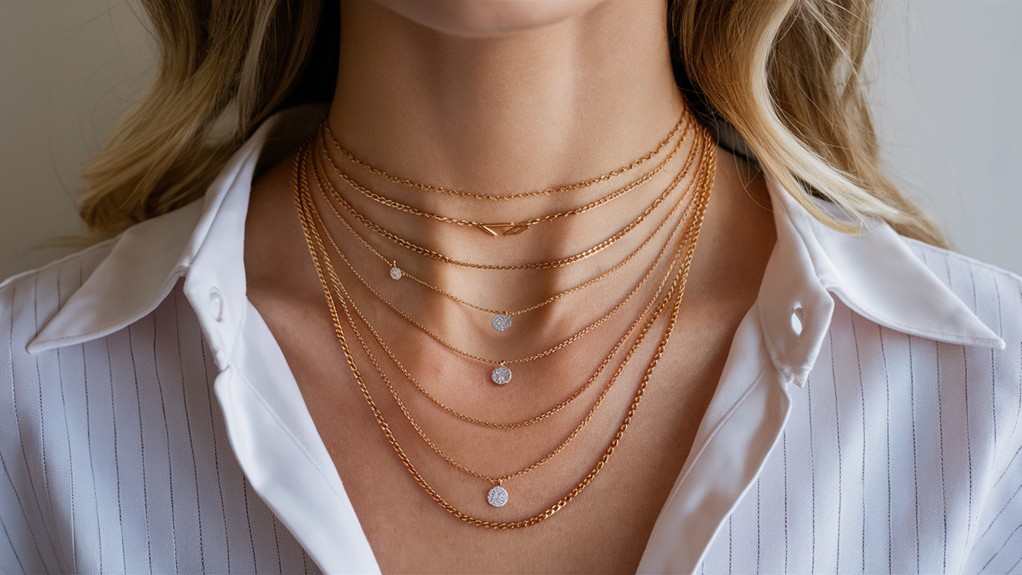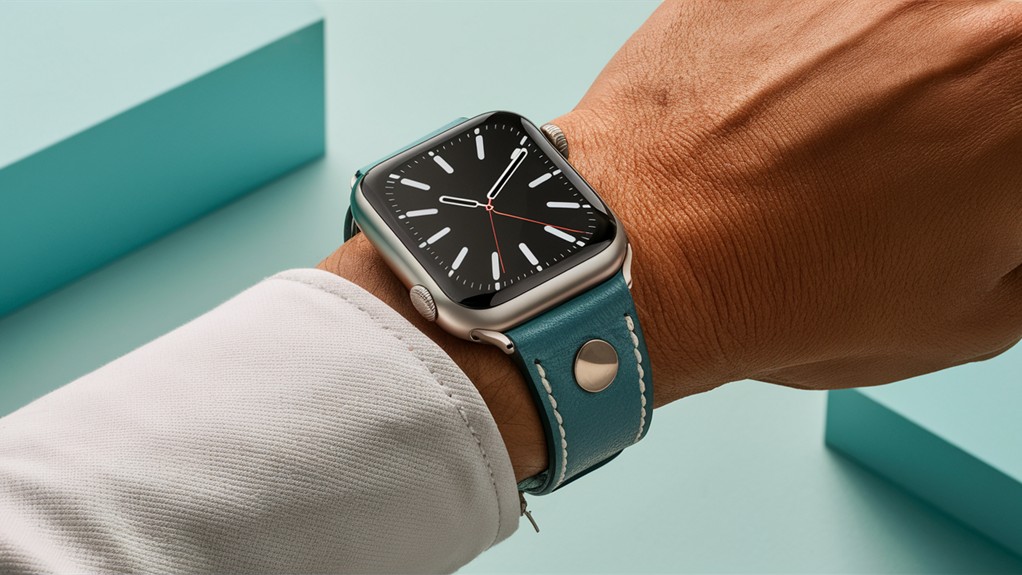When you're in the market for a diamond, understanding carat weight is essential to making an informed decision. But how can you accurately estimate a diamond's size without specialized equipment? That's where a diamond carat weight calculator comes in handy. This invaluable tool can help you determine the approximate weight of a stone based on its dimensions and shape. By mastering the use of this calculator and understanding the factors that influence perceived size, you'll be better equipped to find the perfect diamond that meets your expectations. Let's investigate how you can become a savvy diamond shopper with just a few simple measurements.
Our Highlighted Points
- Accurate measurements of length, width, and depth are crucial for using diamond carat weight calculators effectively.
- Different diamond shapes require specific formulas for carat weight calculation, such as (avg. diameter² x depth x 0.0061) for Round Brilliant cuts.
- Length-to-width ratios significantly impact the visual appearance and weight calculations for fancy-cut diamonds like Marquise and Oval.
- Specialized tools like micrometers are essential for obtaining precise diamond measurements to ensure accurate carat weight calculations.
- Understanding the relationship between carat weight and visual size helps in selecting diamonds that appear larger for their weight.
Understanding Diamond Carat Weight
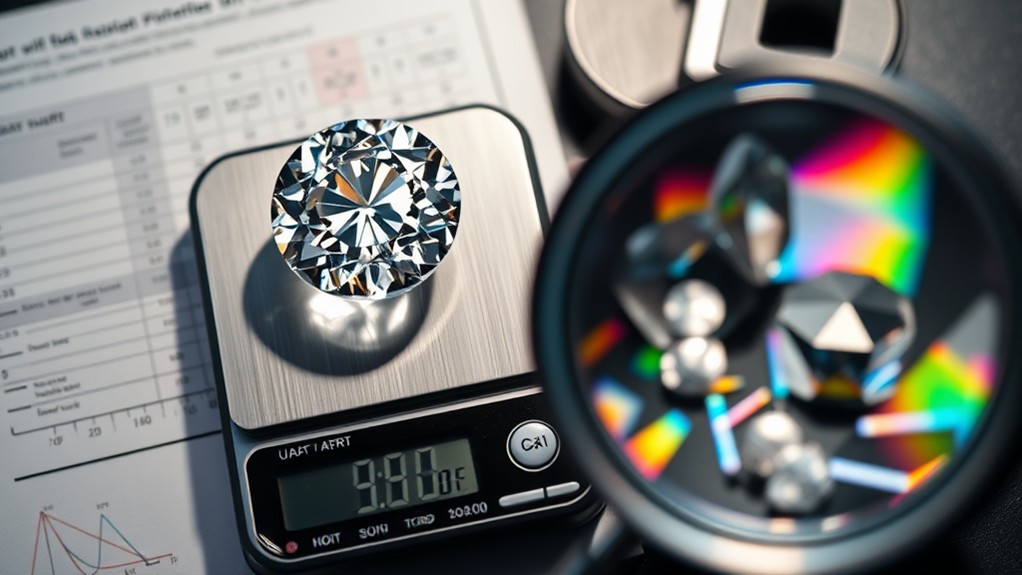
When you're shopping for a diamond, carat weight is one of the most vital factors to take into account. Understanding carat weight and its relationship to a diamond's size is significant for making informed purchasing decisions.
Here's what you need to know:
- Carat weight measures a diamond's mass, with 1 carat equaling 0.2 grams.
- Carat Size refers to the visual appearance of a diamond, which can vary based on shape and cut.
To accurately assess a diamond's carat weight and size:
- Familiarize yourself with standard dimensions for different carat weights.
- Consider the diamond's shape, as it affects how weight translates to size.
- Use a diamond carat weight calculator to estimate size based on measurements.
Remember:
- Round diamonds typically measure 6.5 mm in diameter for 1 carat.
- Other shapes, like oval and princess cuts, have different size equivalents.
- Carat weight is often represented in ranges, with common weights from 0.04 to 0.3 carats.
Importance of Accurate Measurements
The cornerstone of accurate diamond carat weight calculation lies in precise measurements. When determining a diamond's carat weight, you must understand that even minuscule variations in length, width, and depth can greatly impact the estimated weight and value.
To guarantee accuracy:
- Use specialized tools like micrometers for precise dimension measurements
- Take width measurements at the widest point for round diamonds
- Consider specific length-to-width ratios for other shapes, such as oval and pear
Remember, different diamond cuts require unique formulas for carat weight calculation. For instance, the round brilliant cut formula involves multiplying the average diameter squared by the depth and a constant factor of 0.0061.
It's essential to differentiate between carat weight and total carat weight (TCW):
- Carat weight: Pertains to a single diamond
- Total carat weight: Accounts for multiple stones in a setting
Diamond Shapes and Sizes
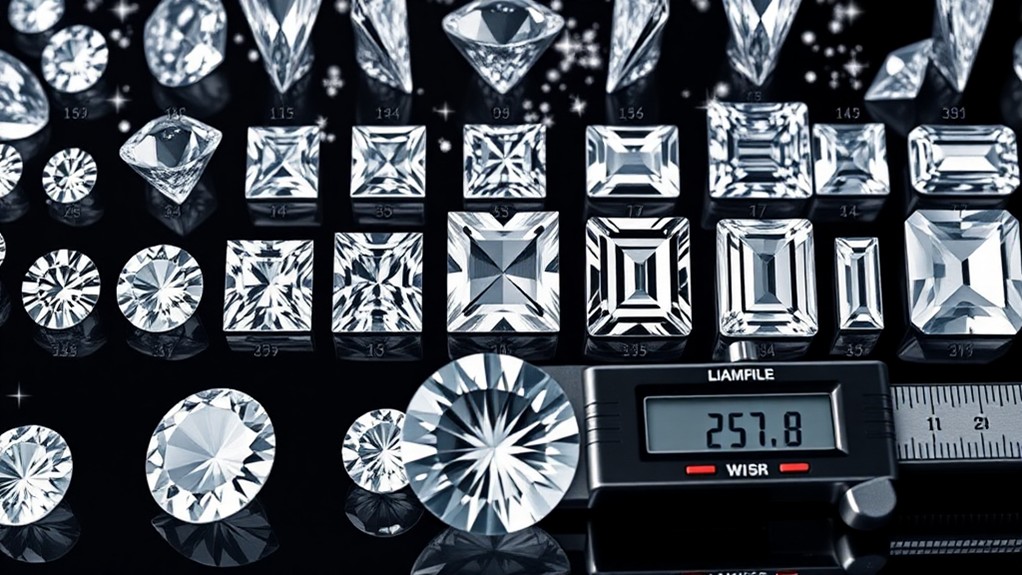
Diamonds dazzle in an assortment of shapes and sizes, each with its own unique charm and characteristics. When selecting a diamond, it's essential to understand how different shapes affect the appearance and carat weights of these precious stones.
The most common shapes include:
- Round Brilliant
- Princess
- Oval
- Cushion
- Pear
Each shape has specific dimensions that correspond to its carat weight. For instance, a 1-carat Round Brilliant cut diamond typically measures about 6.5 mm in diameter, while a Princess cut of the same weight is approximately 5.5 mm.
It's vital to recognize that cut quality and shape can influence the perceived size of the diamond, with deeper cuts often appearing smaller.
To accurately compare different shapes and sizes, you'll find a diamond size chart invaluable. This tool helps you visualize the differences in size and weight across diverse diamond shapes, aiding in selection and comparison.
Using the Carat Weight Calculator
In order to accurately estimate a diamond's carat weight, you'll need to utilize a carat weight calculator. This tool employs specific formulas tailored to different diamond cuts, ensuring precise estimations based on the stone's measurements.
For instance, round brilliant cuts use the formula (avg. diameter x avg. diameter x depth x 0.0061), while oval cuts employ (avg. diameter x avg. diameter x depth x 0.0062).
To use the calculator effectively:
- Measure the diamond's dimensions accurately using tools like micrometers.
- Select the appropriate formula based on the diamond's cut.
- Input the measurements into the calculator.
- Consider length-to-width ratios for fancy cuts, as they influence weight calculations.
Formulas for Different Diamond Cuts
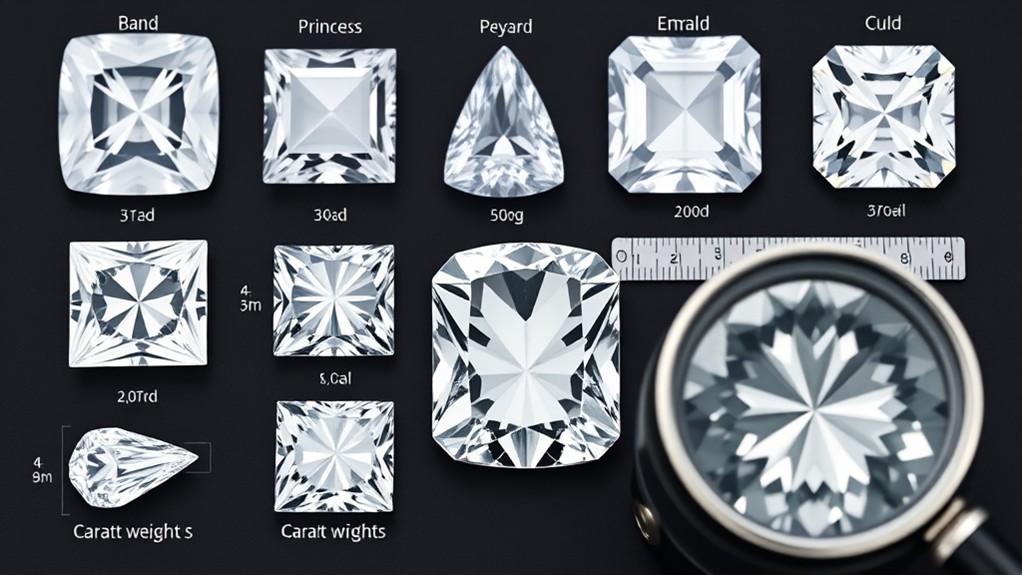
Calculating a diamond's carat weight accurately requires using specific formulas tailored to each cut.
For Round Brilliant Cut diamonds, you'll use the formula: (avg. diameter x avg. diameter x depth x 0.0061) = carat weight. The average diameter is determined by taking the mean of the diamond's length and width measurements.
Oval Brilliant Cut diamonds utilize a slightly modified formula: (avg. diameter x avg. diameter x depth x 0.0062) = carat weight. This adjustment accounts for the elongated shape of oval diamonds.
For Heart Shape diamonds, the formula becomes: (length x width x depth x 0.0059) = carat weight. This calculation considers the unique dimensions of this romantic cut.
Marquise and Pear Shape diamonds follow a similar pattern: (length x width x depth x adjustment factor) = carat weight. The adjustment factor varies based on the diamond's length-to-width ratio, ensuring accurate results for these distinctive cuts.
Using these formulas in conjunction with a Diamond Size Chart and Weight Calculator will help you determine the precise carat weight of loose diamonds.
Keep in mind that while carat weight is essential, a diamond's cut can greatly influence how large it appears, regardless of its mm size.
Length-to-Width Ratio Explained
A fundamental aspect of diamond assessment, the length-to-width ratio plays a significant role in determining a stone's visual appeal. This ratio, calculated by dividing a diamond's length by its width, greatly influences the perceived shape and elegance of the gem.
For instance, a marquise cut diamond with a 2:1 ratio will appear more elongated and slender compared to one with a 1.5:1 ratio, which results in a rounder appearance.
Understanding the ideal length-to-width ratio for different diamond shapes is important when selecting a stone that aligns with your aesthetic preferences. Consider the following guidelines:
- Round diamonds typically have a 1:1 ratio for optimal symmetry
- Pear shapes often range from 1.5:1 to 1.75:1 for balanced proportions
- Marquise cuts can vary from 1.75:1 to 2.25:1, depending on desired elongation
When using a carat weight calculator, it's important to account for the length-to-width ratio, as different ratios may require specific adjustment factors to achieve accurate weight estimations.
Factors Affecting Perceived Size
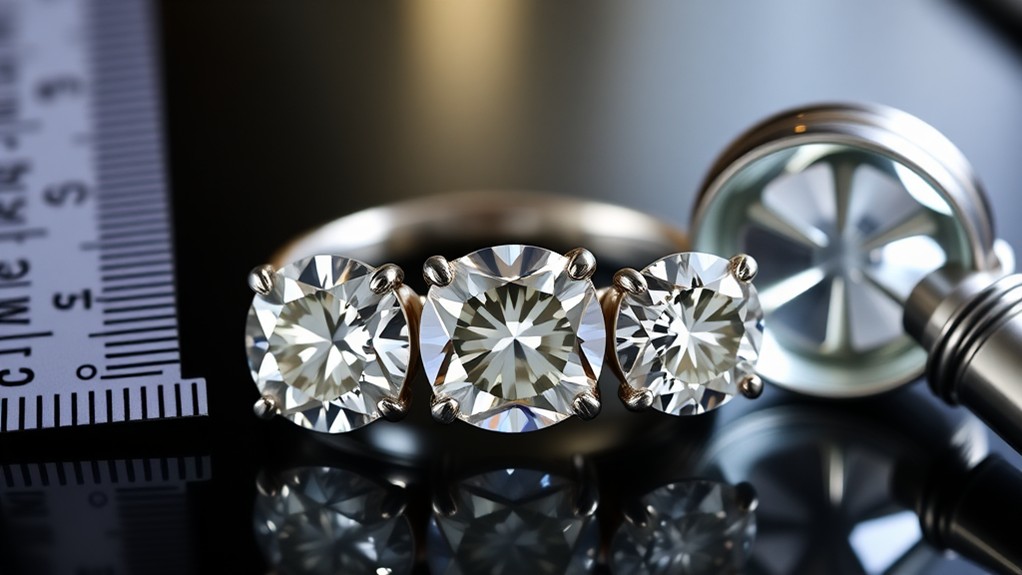
While the length-to-width ratio affects a diamond's appearance, several other factors influence its perceived size. To optimize the visual impact of your diamond, consider the following elements:
- Cut Quality:
- An ideal cut improves brilliance and light reflection
- Well-executed proportions create the illusion of a larger stone
- Diamond Shape:
- Fancy shapes like oval and marquise can appear larger than round diamonds of equal carat weight
- Elongated forms distribute weight across a larger surface area
- Setting Type:
- Halo settings surround the center stone with smaller diamonds
- This technique can make the main diamond look considerably larger
- Depth and Width Ratios:
- Deeper cuts may cause diamonds to appear smaller than their actual carat weight
- Optimal depth-to-width ratios vary by shape and can improve perceived size
- Carat Weight Distribution:
- How weight is distributed across the diamond's dimensions affects its appearance
- Fancy cuts like pear shapes can be manipulated to appear larger through strategic weight distribution
Common Errors in Size Estimation
Many diamond enthusiasts fall prey to common errors when estimating a stone's size. One of the most frequent mistakes is relying solely on carat weight without considering the diamond's actual dimensions. This oversight can lead to inaccurate perceptions of a stone's appearance, as different shapes can appear larger or smaller for the same carat weight.
Another vital error is neglecting the impact of depth and cut quality on a diamond's visual impact. A poorly cut stone may appear smaller than its carat weight suggests, while an expertly cut diamond can enhance light reflection and appear larger.
To avoid these pitfalls, you should:
- Use measurement tools like micrometers for accurate dimension assessment
- Consult size comparison charts specific to different diamond shapes
- Consider length-to-width ratios, especially for fancy cuts like marquise or oval
It's important to understand that visual inspection alone is insufficient for precise size estimation. Relying on specific size charts and measurement tools is imperative for accurate carat weight calculations.
Practical Tips for Measurement
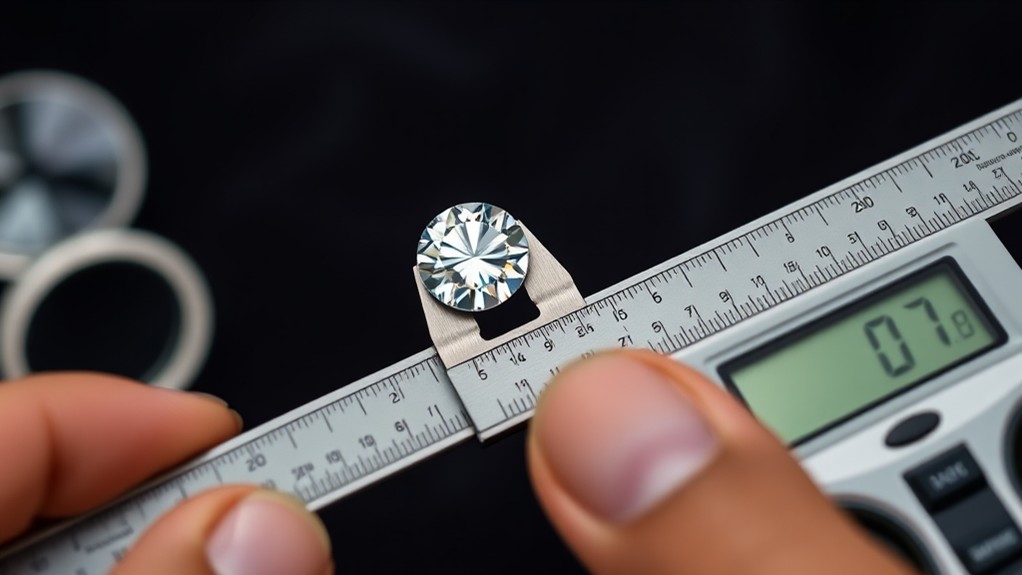
Precision-focused measurement techniques are essential for accurate diamond assessment. To guarantee the most precise measurements, you'll need to use a micrometer for determining a diamond's length, width, and depth.
Keep in mind that even small discrepancies can greatly impact carat weight calculations, so attention to detail is paramount.
When measuring round diamonds, focus on the widest point to determine the diameter. For fancy shapes, you'll need to take individual length and width measurements. Each diamond shape requires a specific formula for calculating carat weight. For example, oval and pear shapes use the formula: (average diameter x depth x adjustment factor).
To improve your understanding of diamond sizes:
- Regularly consult a diamond carat size chart
- Compare different shapes and weights visually
- Familiarize yourself with the difference between carat weight and total carat weight (TCW)
Bear in mind that TCW accounts for multiple stones in a setting, which can affect the complete value.
Maximizing Value in Diamond Selection
Now that you've mastered the art of precise diamond measurement, it's time to focus on optimizing value in your diamond selection.
Understanding the 4Cs—Cut, Color, Clarity, and Carat—is essential for improving your investment. Prioritize cut quality, as an ideal cut boosts a diamond's brilliance and perceived size, potentially increasing its market value.
When considering carat weight, keep in mind that prices increase exponentially with size. To optimize your budget:
- Choose a diamond just below popular carat milestones (e.g., 0.95ct instead of 1.0ct)
- Consider shapes like oval or marquise, which appear larger than round cuts of equal weight
- Opt for ethically sourced and certified diamonds for improved resale potential
Frequently Asked Questions
How to Measure Carat Weight of Stone?
To measure a stone's carat weight, you'll need to use specific formulas based on its cut. Measure the stone's dimensions accurately, including average diameter and depth. Use the appropriate formula for the shape to calculate the carat weight precisely.
How Do You Calculate the Carat of a Diamond by Size?
To calculate a diamond's carat by size, you'll need its dimensions. Measure length, width, and depth accurately. Use specific formulas based on the diamond's cut, like round or oval. Multiply the results by the appropriate adjustment factor.
How Do You Measure Diamond Stone Size?
To measure diamond stone size, you'll need a caliper or micrometer. Measure the length, width, and depth in millimeters. For round diamonds, measure the width at the widest point. Be precise, as these measurements determine carat weight.
What Is the Carat Weight Conversion for Gemstones?
You'll find that gemstone carat weight conversion is straightforward: 1 carat equals 200 milligrams or 0.2 grams. You can use this standard measurement to compare different stones' weights, regardless of their type or shape. When you want to assess a gemstone’s value, carat weight is just one factor to consider. Other important aspects include the gemstone’s color, clarity, and cut. For example, when you’re evaluating a natural spinel gemstone value compare, you’ll also want to take into account its hue, saturation, and any visible inclusions. By considering all of these factors together, you can make an informed decision about the worth of a gemstone.

